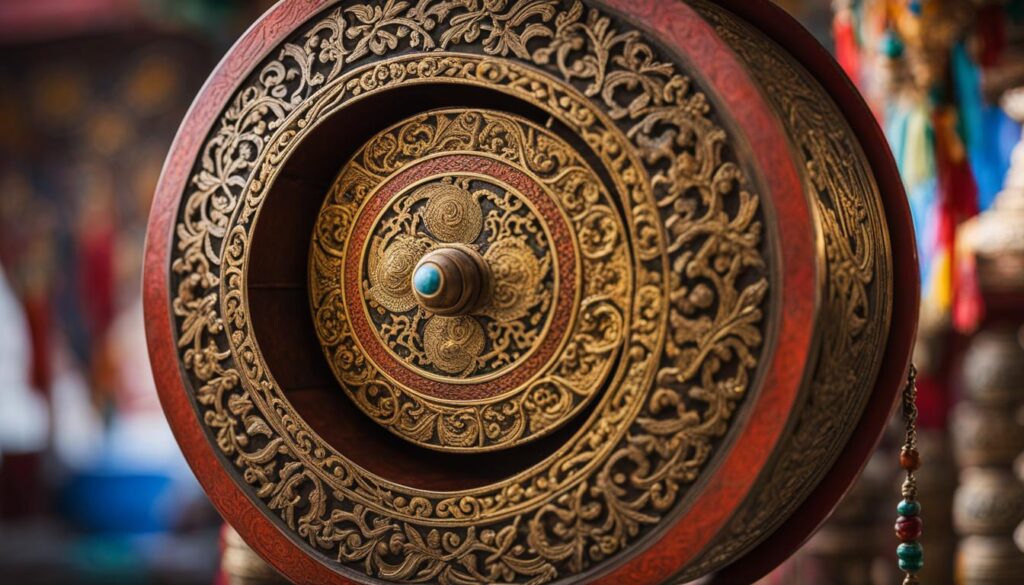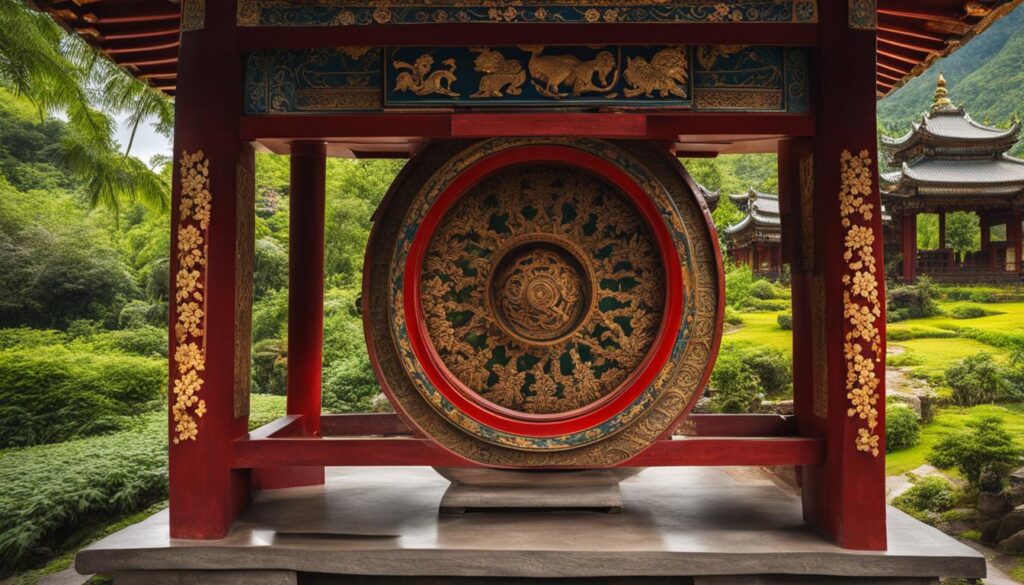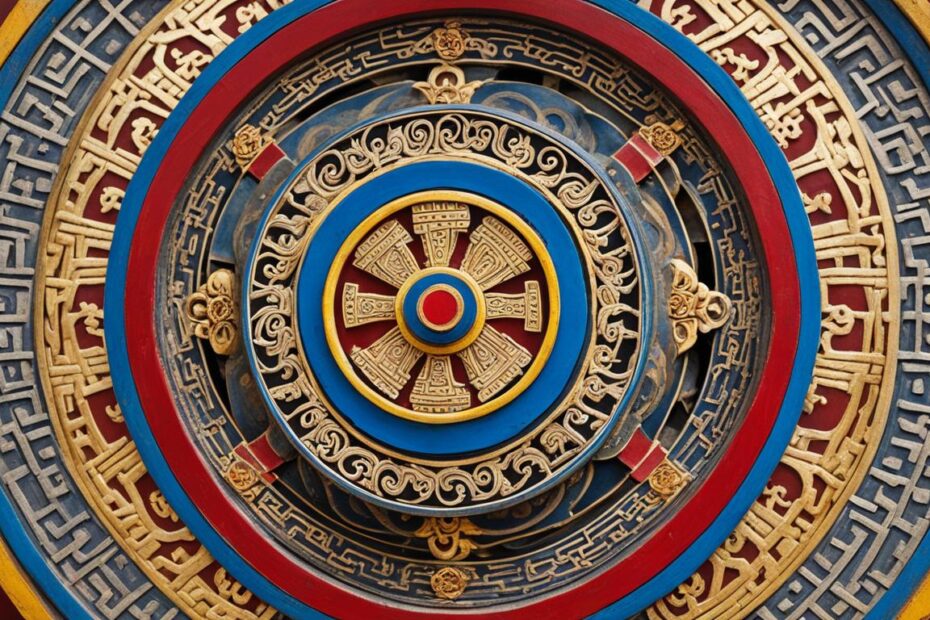Prayer wheels hold a sacred place in the traditions and practices of Tibetan Buddhism. These cylindrical devices are adorned with Buddhist mantras and are used for accumulating merit and blessings through the act of spinning them clockwise. Made from metal, wood, or cloth, prayer wheels are considered religious artifacts and serve as powerful tools in spiritual practice.
The origin of prayer wheels can be traced back to the 7th and 9th centuries, although the exact history remains uncertain. The most common type of prayer wheel is the Mani wheel, widely used by Buddhists in Tibet, Bhutan, Mongolia, and northern India. These wheels are believed to promote peace, compassion, and understanding through mantra recitation and the spinning motion.
Prayer wheels are seen as sacred objects in Buddhist traditions and are deeply rooted in religious customs. They are known for their ability to create spiritual transformation and insight, helping practitioners deepen their connection with the divine. Additionally, prayer wheels play a significant role in meditation, aiding in concentration and mindfulness.
Key Takeaways:
- Prayer wheels are cylindrical devices used in Tibetan Buddhism for accumulating merit and blessings through clockwise spinning.
- The most common type is the Mani wheel, used by Buddhists in Tibet, Bhutan, Mongolia, and northern India.
- Prayer wheels are considered sacred objects and promote peace, compassion, and understanding.
- They have a long history rooted in Buddhist traditions and are symbols of religious customs.
- Prayer wheels are used in meditation practices to enhance concentration and mindfulness.
What are Prayer Wheels in Buddhism?
Prayer wheels hold deep significance in the practice of Tibetan Buddhism. These cylindrical devices are made of metal, wood, or cloth and contain sacred Buddhist mantras. Spinning the prayer wheel in a clockwise direction is believed to accumulate merit and blessings for the practitioner.
The most common type of prayer wheel is the Mani wheel, which is a small handheld version used by Buddhists in Tibet, Bhutan, Mongolia, and northern India. The act of spinning the prayer wheel is believed to amplify the power of the mantra within, leading to spiritual transformation and insight.
Auspicious symbols, such as lotus flowers or golden fish, are often adorned on the outside of the prayer wheels. These symbols are representative of purity, enlightenment, and good fortune.
The Power of Spinning
Spinning a prayer wheel serves as an integral part of Buddhist spiritual practice. Each rotation of the wheel is believed to release the power of the mantras inscribed on it, spreading spiritual vibrations and positive energy into the environment.
Just as a single drop of water can create ripples that expand in all directions, the spinning of a prayer wheel has a ripple effect, touching the hearts and minds of all beings.
By spinning the prayer wheel, practitioners engage in a form of meditation and mantra recitation. It is a way to connect with the teachings of the Buddha and to cultivate peace, compassion, and understanding.
Embracing the Divine Essence
Prayer wheels play a vital role in the religious customs of Tibetan Buddhism, serving as tangible reminders of the continuous nature of prayer and the universal desire for spiritual harmony. They are treated as sacred objects, representing the devotion and reverence of the practitioners.

| Type | Materials | Auspicious Symbols |
|---|---|---|
| Mani Wheel | Metal, wood, or cloth | Lotus flowers, golden fish |
| Large Prayer Wheels | Wood or metal | Sanskrit inscriptions, religious images |
| Water-Powered Wheels | Wood or metal | Dragon engravings, flowing water |
| Wind-Powered Wheels | Wood or metal | Windhorse symbol, spinning blades |
These sacred artifacts can be found within temple grounds, shrines, and other places of worship, with Tibet and the Himalayan regions being home to a large number of prayer wheels. The devotion and practice associated with these wheels offer a tangible way for practitioners to embrace the divine essence and seek spiritual growth.
In the next section, we will explore the fascinating history of the Buddhist prayer wheel, shedding light on its origins and evolution throughout the centuries.
History of the Buddhist Prayer Wheel
The exact origin of the Buddhist prayer wheel is uncertain, with suggested dates ranging from around 400 AD to the 7th and 9th centuries. One theory links the origin to Chinese octagonal book repositories from the 9th century, which had a wooden handle for spinning and were used to store sacred Buddhist literature.
The prayer wheel’s history is closely tied to the teachings of the Buddha, as it is considered a means to accumulate merit, gain insight, and cultivate peace, compassion, and understanding.

“The prayer wheel’s history is deeply intertwined with the essence of Buddhist traditions. It serves as a spiritual tool for practitioners to deepen their connection with the teachings of the Buddha and embark on a transformative journey of self-discovery and enlightenment.” – [Author Name]
Why are Prayer Wheels in Buddhism Significant?
Prayer wheels hold immense significance in Buddhism, playing a pivotal role in spiritual practices, Buddhist traditions, and religious customs. These cylindrical devices are not mere artifacts; they are believed to bring profound spiritual benefits to practitioners who engage with them. The practice of spinning the prayer wheel is regarded as a form of Buddhist prayer, connecting individuals to the profound teachings of the Buddha and facilitating spiritual transformation.
When a practitioner spins the prayer wheel in a clockwise direction, it is believed to purify negative karma, accumulate merit, and generate positive energy. This act of devotion and intentionality serves as a profound spiritual practice that fosters insight into one’s true nature. By engaging with the prayer wheel, individuals can deepen their understanding, cultivate peace, foster compassion, and grow spiritually.
The significance of prayer wheels transcends their physical appearance. They serve as powerful tools for connecting with the divine and cultivating a sense of presence and mindfulness. The repetitive motion of spinning the wheel provides a tangible and meditative experience, enhancing concentration and deepening one’s spiritual connection.
“The practice of spinning the prayer wheel is not just a physical act but a means to purify one’s mind and cultivate inner peace.”
Prayer wheel traditions are rooted in Buddhist teachings and have been practiced for centuries. They offer a unique pathway to spiritual growth, allowing practitioners to accumulate merit, deepen their understanding of the dharma, and foster compassion not only for themselves but for all sentient beings. The significance of prayer wheels lies in their ability to facilitate spiritual evolution, leading individuals on a transformative journey towards enlightenment.
Benefits of Engaging with Prayer Wheels:
- Cultivate insight and self-awareness
- Purify negative karma
- Accumulate merit and positive energy
- Promote peace and compassion
- Foster a deeper connection to the teachings of the Buddha
The spiritual practice of engaging with prayer wheels is not limited to a specific geographical region or cultural context. As Buddhist teachings have spread across the world, individuals from diverse backgrounds have incorporated prayer wheels into their own spiritual practices. This inclusivity allows for a rich tapestry of religious customs and traditions, fostering global understanding, unity, and spiritual harmony.

Types of Buddhist Prayer Wheels
Prayer wheels play a significant role in Tibetan Buddhism, with various types of prayer wheels serving different purposes and styles. These sacred artifacts are categorized into two main groups: human-powered and non-human-powered prayer wheels. Let’s explore the unique characteristics of each category:
Human-Powered Prayer Wheels:
1. Handheld Devices: These prayer wheels are portable and commonly used by individuals during meditation or daily spiritual practices. Handheld prayer wheels offer convenience and ease of use, allowing practitioners to spin the wheel and recite mantras simultaneously, deepening their spiritual connection.
2. Large Structures: Some prayer wheels are built on a larger scale, often found at monasteries, temples, or other religious sites. These structures can range in size, from small freestanding wheels to enormous installations adorned with intricate designs, inspiring awe and reverence in those who encounter them.
Non-Human-Powered Prayer Wheels:
1. Water-Powered Wheels: These prayer wheels are ingeniously designed to utilize the power of flowing water. The flowing water rotates the wheel, creating a continuous spinning motion. These wheels are commonly found near bodies of water, such as rivers or streams, providing a serene and visually captivating experience during prayer or contemplation.
2. Wind-Powered Wheels: Harnessing the natural energy of the wind, these prayer wheels are strategically placed in locations with consistent wind patterns. As the wind blows, it sets the wheel in motion, symbolizing the ever-present and ever-changing nature of spiritual practice.
3. Mechanical Wheels: These prayer wheels are operated by mechanical means, such as pulleys, gears, or motors. They can be found in different sizes and designs, ranging from small tabletop versions to large, mechanized installations. Mechanical prayer wheels serve as a practical solution for individuals who may have limited mobility but still wish to engage in prayer wheel traditions.
Now, let’s take a moment to appreciate the beauty and diversity of Buddhist prayer wheels through the following table:
| Prayer Wheel Type | Description |
|---|---|
| Handheld Devices | Portable prayer wheels used for personal meditation and spiritual practices. |
| Large Structures | Imposing prayer wheels found at monasteries and temples, designed to inspire reverence and devotion. |
| Water-Powered Wheels | Prayer wheels ingeniously designed to rotate through the power of flowing water. |
| Wind-Powered Wheels | Prayer wheels that utilize the wind’s energy to create a continuous spinning motion. |
| Mechanical Wheels | Prayer wheels operated by mechanical means, such as pulleys, gears, or motors. |
Through the diversity of prayer wheel traditions, Tibetan Buddhism embraces the belief that spiritual connection and transformation can be achieved through various means, inviting individuals to explore their own path within the rich tapestry of Buddhist practices.

Prayer Wheel Facts
Exploring some unique aspects of prayer wheels in Buddhism reveals their spiritual significance and usage. Prayer wheels are cylindrical objects containing mantras, sutras, or other sacred symbols inscribed on them. Each spin of the prayer wheel is believed to have the same effect as reciting the mantras or sutras, helping the practitioner accumulate merit, wisdom, compassion, and progress on their spiritual path. Prayer wheels can be found at temples, shrines, and other sacred sites, with Tibet and the Himalayan regions having a large number of prayer wheels.

The Spiritual Power of Prayer Wheels
Prayer wheels are not simply religious artifacts; they hold profound spiritual significance. The inscriptions on the prayer wheel represent sacred mantras, sutras, or prayers that embody the teachings of Buddhism. As the practitioner spins the wheel, they are engaging in a spiritual practice known as mantra recitation. This practice is believed to generate positive energy, purify negative karma, and accumulate merit.
The repetitive motion of spinning the prayer wheel has a meditative quality, promoting mindfulness and focus. With each revolution, the practitioner’s mind is drawn to the spiritual meanings contained within the inscriptions. The act of spinning the prayer wheel becomes a form of devotion, connecting the practitioner to the divine and cultivating a deeper understanding of Buddhist teachings.
“The spinning of the prayer wheel is not just a physical action; it is a spiritual journey. With every turn, we are reminded of our connection to the divine and our commitment to walking the path of compassion and wisdom.” – Lama Tenzin Norbu
Prayer Wheels as Religious Custom
Prayer wheels are not limited to temples and shrines; they are also an integral part of religious customs in Tibetan Buddhist communities. Devout Buddhists often carry handheld prayer wheels with them, using them as personal spiritual tools. The portability of these prayer wheels allows practitioners to engage in mantra recitation and seek blessings wherever they go.
Additionally, larger prayer wheels can be found in public spaces, such as monasteries and pilgrimage sites. These prayer wheels are often decorated with intricate designs and craftsmanship, symbolizing the sacredness of the space they occupy. Visitors are encouraged to spin these larger prayer wheels as part of their spiritual journey, offering prayers and aspirations as they do so.
Spreading the Practice of Prayer Wheels
While traditionally associated with Tibetan Buddhism, the practice of using prayer wheels has transcended cultural and geographical boundaries. As interest in Buddhist traditions and spirituality continues to grow worldwide, prayer wheels have gained popularity among practitioners from various backgrounds.
To cater to a broader audience, prayer wheels are now available in different sizes, materials, and designs. Some modern prayer wheels incorporate electronic components, allowing for automated spinning. Others are made from eco-friendly materials, reflecting a commitment to environmental sustainability.
Benefits of Prayer Wheel Practice
The practice of spinning prayer wheels offers numerous benefits to spiritual seekers:
- Spiritual Connection: Prayer wheels serve as a tangible link to the divine, fostering a deep sense of spiritual connection and oneness.
- Mindfulness and Presence: The repetitive motion of spinning the wheel cultivates mindfulness, bringing practitioners into the present moment and enhancing their focus.
- Accumulation of Merit: Each rotation of the prayer wheel is believed to accumulate merit, leading to spiritual growth and favorable conditions in this life and future lives.
- Wisdom and Compassion: The recitation of mantras and prayers while spinning the wheel deepens wisdom and compassion, promoting personal transformation and benefiting all beings.
Incorporating the practice of spinning prayer wheels into one’s spiritual routine can enrich and deepen their spiritual journey, regardless of their religious background.
| Benefit | Description |
|---|---|
| Spiritual Connection | Prayer wheels serve as a tangible link to the divine, fostering a deep sense of spiritual connection and oneness. |
| Mindfulness and Presence | The repetitive motion of spinning the wheel cultivates mindfulness, bringing practitioners into the present moment and enhancing their focus. |
| Accumulation of Merit | Each rotation of the prayer wheel is believed to accumulate merit, leading to spiritual growth and favorable conditions in this life and future lives. |
| Wisdom and Compassion | The recitation of mantras and prayers while spinning the wheel deepens wisdom and compassion, promoting personal transformation and benefiting all beings. |
Christian Prayer Wheel
In the late 20th century, the Christian Prayer Wheel emerged as a beautiful adaptation of the prayer wheel concept, incorporating Christian contemplative practices and the symbolism of the prayer wheel. This unique adaptation holds its own distinct significance within the Christian faith, offering believers a tangible tool for spiritual connection and growth.
The Christian Prayer Wheel features a circular wheel adorned with inscriptions of Christian prayers or verses, such as the Lord’s Prayer or the Beatitudes. Spinners of the wheel engage in prayer or meditation on the verses as they rotate the wheel, using this physical representation as a constant reminder and symbol of their ongoing communication with God.
Similar to its Buddhist counterpart, the Christian Prayer Wheel serves as an aid to contemplative practices and fosters a deeper connection with the divine. It encourages believers to engage in regular moments of prayer and reflection, aligning their hearts and minds with God’s teachings.
“The Christian Prayer Wheel is a powerful tool that reminds us of our continuous need for dialogue with God. As we spin the wheel and recite the meaningful verses inscribed upon it, we are drawn closer to His presence and find renewed purpose in our spiritual lives.”
Integrating the Christian Prayer Wheel into Hours of Prayer
Christian contemplative practices often center around dedicated hours of prayer observed throughout the day. These sacred moments provide opportunities for believers to seek God’s guidance, offer gratitude, and find solace in His presence. The Christian Prayer Wheel can serve as a valuable addition to these hours of prayer, enhancing the spiritual experience and deepening one’s relationship with God.
Here is an example of how the Christian Prayer Wheel can be incorporated into the sacred hours of prayer:
| Hour of Prayer | Prayer Wheel Practice |
|---|---|
| Morning Prayer (Matins or Lauds) | Start the day by spinning the Christian Prayer Wheel and reciting the Lord’s Prayer, asking for guidance and strength throughout the day. |
| Noonday Prayer (Sext) | Take a moment to meditate on a verse inscribed on the Christian Prayer Wheel, reflecting on its meaning and seeking God’s presence in the midst of the day. |
| Afternoon Prayer (None) | Rotate the Prayer Wheel as you offer prayers of thanksgiving, expressing gratitude for the blessings of the day and seeking God’s continued guidance. |
| Evening Prayer (Vespers) | Engage in quiet reflection while spinning the Christian Prayer Wheel, inviting God’s peace and wisdom into your heart as you prepare for rest. |
| Night Prayer (Compline) | As you wind down for the night, utilize the Christian Prayer Wheel to recite a bedtime prayer, finding comfort in God’s presence as you settle into sleep. |
By integrating the Christian Prayer Wheel into these sacred hours, believers create a tangible link between their prayers, the words of scripture, and the practice of contemplation. The continuous rotation of the wheel, accompanied by prayer and meditation, serves as a reminder of the constant connection between the believer and God.
Whether spinning a Tibetan prayer wheel or using a Christian Prayer Wheel, these sacred artifacts provide a means of deepening one’s faith and fostering a sense of spiritual harmony. The Christian Prayer Wheel, with its Christian contemplative practices and hours of prayer, invites believers to embark on a meaningful journey of prayer and reflection, drawing them closer to God’s presence in their lives.
The Sacred Hour of Prayer
The sacred hour of prayer is a treasured time for Christians to connect with God and experience communion with the divine. It involves setting aside specific moments throughout the day for prayer and reflection, allowing individuals to seek guidance, peace, and spiritual renewal. By incorporating the Christian Prayer Wheel into these sacred hours of prayer, believers can enrich their relationship with God and enhance their spiritual practice.
There are several common hours of prayer observed by Christians, each serving as a reminder of God’s presence and an opportunity for deepening one’s faith. These hours include:
- Morning prayer (Matins or Lauds): A time to start the day in prayer, offering gratitude, and seeking divine guidance for the day ahead.
- Noonday prayer (Sext): A midday moment of reflection and renewal, allowing for a pause amidst the busyness of life to connect with God.
- Afternoon prayer (None): An opportunity to seek solace and serenity in the midst of daily challenges, finding strength through prayer.
- Evening prayer (Vespers): A time for reflection and gratitude as the day draws to a close, offering prayers for a peaceful and restful night.
- Night prayer (Compline): A moment of surrender and trust, entrusting one’s cares and concerns to God’s care before sleep.
The Christian Prayer Wheel can be incorporated into these sacred hours of prayer as a tool to enhance one’s spiritual routine. By spinning the prayer wheel and reciting the prayers inscribed upon it, individuals engage in a physical and symbolic act of continuous communication with God. The repetitive nature of spinning the wheel fosters mindfulness, concentration, and a deeper connection to the divine presence.
Integrating Prayer Wheels into Your Spiritual Practice
To effectively integrate prayer wheels into your spiritual practice, it is essential to approach it with clear intentions and develop a consistent routine that aligns with your beliefs and values. The repetitive act of spinning the prayer wheel can be a powerful tool for cultivating mindfulness, enhancing concentration, and deepening your spiritual connection.
As you engage with the prayer wheel, consider incorporating meditation and visualization techniques to enhance your practice. Close your eyes and envision the positive energy and blessings emanating from the wheel as you spin it.
Reciting mantras or prayers while spinning the prayer wheel can amplify the spiritual benefits. Choose prayers or mantras that resonate with your spiritual journey and chant them softly or silently as you engage with the wheel. This combination of physical action and vocalized intention creates a harmonious rhythm that can heighten your spiritual experience.
Prayer Wheel Materials and Variations
Prayer wheels come in various materials and styles, each with its own unique characteristics. Some are made of traditional materials like metal, wood, or cloth, while others may incorporate modern elements such as electronic components or eco-friendly materials.
Table: Comparison of Materials and Styles
| Material | Characteristics |
|---|---|
| Metal | Durable and often intricately designed. Represents strength and offers a sense of permanence. |
| Wood | Natural and grounding. Provides a tactile connection to nature and the earth. |
| Cloth | Lightweight and portable. Easy to carry and suitable for travel or personal use. |
| Electronic | Incorporates modern technology for convenient use. Supports a sustainable approach to spiritual practice. |
| Eco-friendly | Utilizes sustainable and environmentally friendly materials. Reflects a commitment to the planet and consciousness. |
These various material options allow practitioners to choose a prayer wheel that resonates with their personal preferences, values, and intentions while embracing the timeless traditions of prayer wheel practice.
Image: Tibetan prayer wheel
The Global Adoption of Prayer Wheels
While prayer wheels have deep roots in Tibetan Buddhist traditions, their popularity and significance have extended far beyond Tibet. Today, practitioners from various spiritual backgrounds and traditions worldwide incorporate prayer wheels into their own practices.
Table: Famous Prayer Wheel Traditions
| Tradition | Location |
|---|---|
| Tibetan Buddhism | Tibet, Bhutan, Mongolia, northern India |
| Christianity | Global |
| Hinduism | India, Nepal |
| Taoism | China |
| Interfaith | Worldwide |
The widespread adoption of prayer wheels reflects the universal human longing for spiritual connection and peace. Whether spinning a Tibetan prayer wheel or engaging with a Christian Prayer Wheel, individuals find solace, renewal, and inspiration through this sacred practice.
“The prayer wheel is a universal symbol of our shared aspiration for love, compassion, and peace.”
As the practice of utilizing prayer wheels continues to evolve and expand, practitioners cultivate a collective harmony that transcends cultural boundaries and fosters a deeper understanding of the interconnectedness of all spiritual traditions.
Conclusion
Prayer wheels are more than just religious artifacts; they are powerful tools that hold deep significance in spiritual practices. Whether used in Tibetan Buddhism or the Christian tradition, prayer wheels offer practitioners a tangible way to deepen their faith, cultivate spiritual growth, and foster peace and compassion.
Engaging with prayer wheels, whether spinning a Tibetan prayer wheel or using a Christian Prayer Wheel, can facilitate inner transformation and enhance one’s connection to the divine. The continuous act of spinning the wheel serves as a reminder of the unceasing nature of prayer and the universal desire for spiritual harmony.
By embracing the magic of mantras and the power of prayer wheels, individuals can embark on a profound spiritual journey that not only enriches their personal lives but also contributes to global understanding and unity. The practice of incorporating prayer wheels into meditation and contemplation can further deepen the experience, leading to heightened mindfulness, increased concentration, and a stronger sense of inner peace.
FAQ
What are prayer wheels in Buddhism?
Prayer wheels are cylindrical devices associated with Tibetan Buddhism that contain Buddhist mantras. They are used for accumulating merit and blessings through clockwise spinning.
What is the history of the Buddhist prayer wheel?
The exact origin of the prayer wheel is uncertain, but it is believed to have appeared around the 7th and 9th centuries. One theory connects its origin to Chinese octagonal book repositories from the 9th century.
Why are prayer wheels significant in Buddhism?
Prayer wheels are significant in Buddhism as they are believed to bring spiritual benefits to practitioners. Spinning the wheel is thought to purify negative karma, accumulate merit, and generate positive energy.
What are the different types of Buddhist prayer wheels?
There are several types of Buddhist prayer wheels, including handheld devices and large structures. They can be human-powered or non-human-powered, and vary in size, design, and materials used.
What are some facts about prayer wheels?
Prayer wheels are cylindrical objects that contain mantras or sacred symbols inscribed on them. Each spin of the prayer wheel accumulates merit and wisdom, and they are often found at temples and sacred sites.
What is the Christian Prayer Wheel?
The Christian Prayer Wheel is a Christian adaptation of the prayer wheel concept, incorporating Christian contemplative practices and the symbolism of the prayer wheel.
What is the sacred hour of prayer?
The sacred hour of prayer is a dedicated time for prayer and communion with God observed by Christians. It involves setting aside specific moments throughout the day for prayer and reflection.
How can prayer wheels be integrated into a spiritual practice?
To effectively integrate prayer wheels into a spiritual practice, it is important to set clear intentions, develop a consistent routine, combine their use with meditation and visualization, and recite mantras or prayers while spinning the wheel.
How can prayer wheels be used in meditation?
Prayer wheels can be used in meditation by spinning them while focusing on the mantra or sacred symbol inscribed on the wheel. This repetitive motion helps to cultivate mindfulness, enhance concentration, and deepen spiritual connection.
What is the significance of prayer wheels in religious traditions?
Prayer wheels are powerful tools in both Tibetan Buddhism and Christian traditions, offering practitioners a means to deepen their faith, cultivate spiritual growth, and foster peace and compassion.









